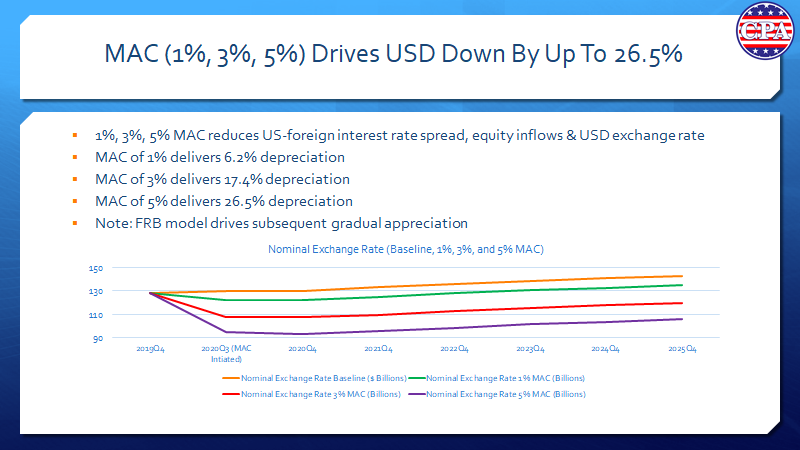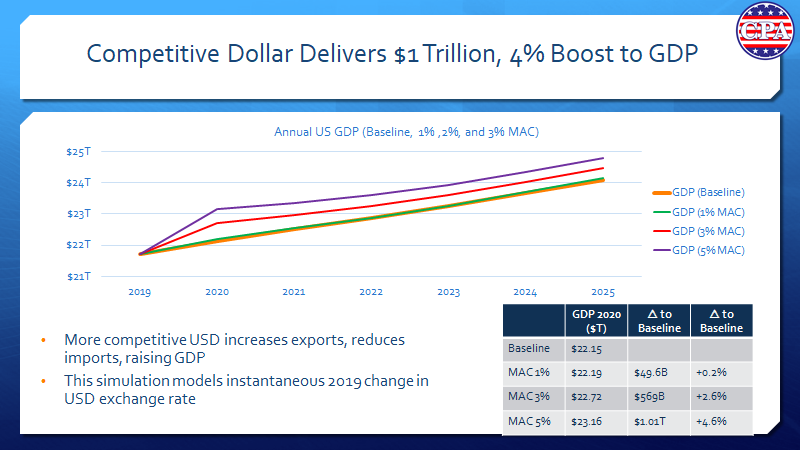For those of us who support the Made in America/Buy American movement and want to rebuild American manufacturing by returning manufacturing to America through reshoring from China, it’s important to consider the policies of President Trump and former V.P. Biden in their bid to be president. Two policies, tax rates and the cost and availability of energy, have a major effect on where a company chooses to locate their manufacturing or headquarters if they have multiple plants globally. If the corporation has a plant in a country with a lower tax rate, they may choose to shift their profits to the subsidiary in that country. Bulgaria and the Czech Republic at 10% and Ireland at 12.5% have the lowest corporate tax rates in Europe. American manufacturers that don’t have plants in other countries face the brunt of the tax burden. Personal tax rates are also important as only 30-35% of manufacturers are C corporations; the others are LLCs, partnerships or sole proprietorships where taxes are passed through to the owner(s).
Taxes
Biden’s Tax Policies:
- Raise the corporate tax rate to 28%.
- Require a true minimum tax of 21% on ALL foreign earnings of United States companies located overseas (double the current rate).
- Impose a tax penalty on corporations that ship jobs overseas in order to sell products back to America.
- Impose a 15% minimum tax on book income so that no corporation gets away with paying no taxes.
- Raise the top individual income rate back to 39.6%.
- Require those making more than $1 million to pay the same rate on investment income that they do on their wages.
Trump’s Tax Policies:
The U.S. had a corporate tax rate ranging from a low of 15% to a high of 35% until the Tax Cuts and Jobs Act (TCJA) was passed by Congress on December 20, 2017, which reduced the corporate tax rate to flat tax of 21%. TCJA also cut capital gains tax to 15 % and increased the estate tax basic exemption amount from $5 million to $10 million.
President Trump’s tax policy platform for re-election focuses largely on promoting and preserving the tax cuts of TCJA and making various tax rate reductions scheduled to expire in 2025 permanent. Before the Republican convention, his campaign released his agenda, which included:
- Cutting taxes “to boost take-home pay and keep jobs in America”
- Enacting “Made in America” tax credits
- Expanding opportunity zones
- Enacting new tax credits “for companies that bring back jobs from China
- Permitting 100% expensing “for essential industries like pharmaceuticals and robotics that bring their manufacturing back to the United States.”
Energy
Biden’s Policies:
Biden’s campaign website.states that he plans to “Move ambitiously to generate clean, American-made electricity to achieve a carbon pollution-free power sector by 2035. This will enable us to meet the existential threat of climate change while creating millions of jobs…”
His plan is for America to achieve a 100% clean energy target by means of:
- advanced nuclear reactors, that are smaller, safer, and more efficient at half the construction cost of today’s reactors;
- refrigeration and air conditioning using refrigerants with no global warming potential;
- using renewables to produce carbon-free hydrogen at a lower cost than hydrogen from shale gas through innovation in technologies like next generation electrolyzers;
- decarbonizing industrial heat needed to make steel, concrete, and chemicals and reimagining carbon-neutral construction materials
- leveraging research in soil management, plant biologies, and agricultural techniques to remove carbon dioxide from the air and store it in the ground; and
- capturing carbon dioxide through direct air capture systems and retrofits to existing industrial and power plant exhausts, followed by permanently sequestering it deep underground or using it to make alternative products like cement.”
Trump’s Policies:
- Since he took office, President Trump has rolled back hundreds of environmental protections, including limits on carbon dioxide emissions from power plants and vehicles, and protections for federal waterways across the country, fulfilling a campaign promise from 2016.
- On June 1, 2017, Trump announced the U.S. withdrawal from the Paris Climate Agreement, saying the deal disadvantaged the US “to the exclusive benefit of other countries.”
- His administration approved oil and gas drilling in Alaska’s Arctic National Wildlife Refuge, which has been off-limits for drilling for decades.
- President Trump supports development of all forms of energy without subsidies, including production of natural gas through fracking
Trade/Tariffs
Biden’s Policies
- Take aggressive trade enforcement actions against China or any other country seeking to undercut American manufacturing through unfair practices, including currency manipulation, anti-competitive dumping, state-owned company abuses, or unfair subsidies.
- Rally our allies in a coordinated effort to pressure the Chinese government and other trade abusers to follow the rules and hold them to account when they do not.
- Confront foreign efforts to steal American intellectual property.
- Address state-sponsored cyber espionage against American companies.
- Apply a carbon adjustment fee against countries that are failing to meet their climate and environmental obligations to make sure that they are forced to internalize the environmental costs they’re now imposing on the rest of the world.
Trump’s Policies:
- On January 23, 2017, Trump signed an order to withdraw from further negotiations on the Trans-Pacific Partnership.
- On September 2, 2017, Trump instructed aides to withdraw from the U.S. trade agreement with South Korea and later renegotiated a better trade agreement.
- On August 16, 2017, the Trump administration began renegotiating NAFTA with Canada and Mexico. NAFTA was replaced with the new United States–Mexico–Canada Agreement (USMCA), signed on November 30, 2018.
- On January 22, 2018, Trump imposed tariffs and quotas on imported solar panels and washing machines.
- ? On March 1, 2018, he announced a 25% tariff on steel imports and a 10% tariff on aluminum.
- On April 3, 2018, Trump announced 25% tariffs on $50 billion in Chinese imported electronics, aerospace, and machinery.
- On April 6, 2018, Trump announced tariffs on $100 billion more of Chinese imports.
- On October 7, 2019 the United States and Japan signed two agreements intended to liberalize bilateral trade. The U.S.- Japan Trade Agreement (USJTA) provides for limited tariff reductions and quota expansions to improve market access.
- On January 15, 2020, President Trump and Vice Premier Liu H of China the US–China Phase One trade deal in Washington DC.
Buy American/Made in America
Biden’s Policies:
- Make a $400 billion Procurement Investment in American products, materials, and services and ensure that they are shipped on U.S.-flagged cargo carriers.
- Retool and Revitalize American Manufacturers, with a particular focus on smaller manufacturers and those owned by women and people of color, through specific incentives, additional resources, and new financing tools.
- Make a New $300 Billion Investment in Research and Development (R&D) and Breakthrough Technologies
- Bring Back Critical Supply Chains to America so we aren’t dependent on China or any other country for the production of critical goods in a crisis.
- Tighten domestic content rules to require more legitimate American content
- Crack down on waivers to Buy American requirements by federal Agencies
- End false advertising by companies that label products as Made in America even if they’re coming from China or elsewhere
- Strengthen and enforce Buy America provisions
- Update international trade rules and associated domestic regulations for Buy American
Trump’s Policies:
Trump’s campaign slogan revolves around continuing his promise to Make America Great Again. One of the ways is to rebuild American manufacturing and create higher paying jobs. He uses protectionism to defend U.S. industries from foreign competition. According to the National Association of Manufacturers (NAM), the U.S. manufacturing sector, added about 450,000 workers during the first three years of Trump’s presidency before the pandemic. Here are some of the actions he has taken as President.
- Launched “opportunity zones” program in 8,766 distressed areas, which, so far, have attracted $75 billion in private capital.
- Cut regulations for businesses
- Issued the following Executive Orders strengthening different aspects of the Buy American Act of 1933:
- EO 13788: “Buy American and Hire American,” April 18, 2017
- EO 13858: Strengthening Buy-American Preferences for Infrastructure Projects,” January 31 2019
President Trump’s campaign website also lists the following goals for his next term:
- Reduce U.S. dependence on Chinese manufacturing and bring back 1 Million Manufacturing Jobs from China
- No Federal Contracts for Companies who Outsource to China
- Grant tax credits to companies that move manufacturing back to United States; tariffs on those that don’t.
Remember that actions speak louder than words, so be sure to compare what a candidate has done and not just what they promise to do in their campaign platform. Be sure to vote. The future of our country is at stake.

